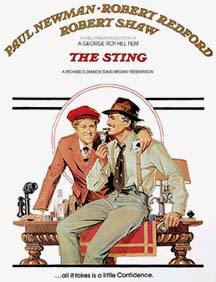Doyle Lonnegan
| The Sting | |
|---|---|

Theatrical release poster by Richard Amsel
|
|
| Directed by | George Roy Hill |
| Produced by |
Tony Bill Michael Phillips Julia Phillips |
| Written by | David S. Ward |
| Starring |
Paul Newman Robert Redford Robert Shaw |
| Music by | Marvin Hamlisch |
| Cinematography | Robert Surtees |
| Edited by | William Reynolds |
| Distributed by | Universal Pictures |
|
Release date
|
|
|
Running time
|
129 minutes |
| Country | United States |
| Language | English |
| Budget | $5.5 million |
| Box office | $159.6 million |
The Sting is a 1973 American caper film set in September 1936, involving a complicated plot by two professional grifters (Paul Newman and Robert Redford) to con a mob boss (Robert Shaw). The film was directed by George Roy Hill, who had directed Newman and Redford in the western Butch Cassidy and the Sundance Kid. Created by screenwriter David S. Ward, the story was inspired by real-life cons perpetrated by brothers Fred and Charley Gondorff and documented by David Maurer in his book The Big Con: The Story of the Confidence Man.
The title phrase refers to the moment when a con artist finishes the "play" and takes the mark's money. If a con is successful, the mark does not realize he has been "taken" (cheated), at least not until the con men are long gone. The film is played out in distinct sections with old-fashioned title cards, the lettering and illustrations rendered in a style reminiscent of the Saturday Evening Post. The film is noted for its anachronistic use of ragtime, particularly the melody "The Entertainer" by Scott Joplin, which was adapted (along with others by Joplin) for the movie by Marvin Hamlisch (and a top-ten chart single for Hamlisch when released as a single from the film's soundtrack). The film's success created a resurgence of interest in Joplin's work.
The Sting was hugely successful at the 46th Academy Awards, being nominated for 10 Oscars and winning seven, including Best Picture, Best Director and Best Original Screenplay.
...
Wikipedia
